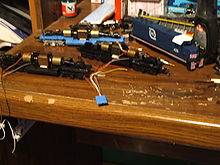- Decoder
-
- For the drum and bass musician, see Decoder (artist). For the band, see Decoder (band)
A decoder is a device which does the reverse operation of an encoder, undoing the encoding so that the original information can be retrieved. The same method used to encode is usually just reversed in order to decode. It is a combinational circuit that converts binary information from n input lines to a maximum of 2n unique output lines.
In digital electronics, a decoder can take the form of a multiple-input, multiple-output logic circuit that converts coded inputs into coded outputs, where the input and output codes are different. e.g. n-to-2n, binary-coded decimal decoders. Enable inputs must be on for the decoder to function, otherwise its outputs assume a single "disabled" output code word. Decoding is necessary in applications such as data multiplexing, 7 segment display and memory address decoding.
The example decoder circuit would be an AND gate because the output of an AND gate is "High" (1) only when all its inputs are "High." Such output is called as "active High output". If instead of AND gate, the NAND gate is connected the output will be "Low" (0) only when all its inputs are "High". Such output is called as "active low output".
A slightly more complex decoder would be the n-to-2n type binary decoders. These type of decoders are combinational circuits that convert binary information from 'n' coded inputs to a maximum of 2n unique outputs. We say a maximum of 2n outputs because in case the 'n' bit coded information has unused bit combinations, the decoder may have less than 2n outputs. We can have 2-to-4 decoder, 3-to-8 decoder or 4-to-16 decoder. We can form a 3-to-8 decoder from two 2-to-4 decoders (with enable signals).
Similarly, we can also form a 4-to-16 decoder by combining two 3-to-8 decoders. In this type of circuit design, the enable inputs of both 3-to-8 decoders originate from a 4th input, which acts as a selector between the two 3-to-8 decoders. This allows the 4th input to enable either the top or bottom decoder, which produces outputs of D(0) through D(7) for the first decoder, and D(8) through D(15) for the second decoder.
A decoder that contains enable inputs is also known as a decoder-demultiplexer. Thus, we have a 4-to-16 decoder produced by adding a 4th input shared among both decoders, producing 16 outputs.
Row select
Most kinds of random-access memory use a n-to-2n decoder to convert the selected address on the address bus to one of the row address select lines. A decoder is a device which does the reverse of an encoder, undoing the encoding so that the original information can be retrieved. The same method used to encode is usually just reversed in order to decode.
Instruction decoder
In CPU design, the instruction decoder is the part of the CPU that converts the bits stored in the instruction register -- or, in CPUs that have microcode, the microinstruction -- into the control signals that control the other parts of the CPU.
A simple CPU with 8 registers may use 3-to-8 logic decoders inside the instruction decoder to select two source registers of the register file to feed into the ALU as well as the destination register to accept the output of the ALU. A typical CPU instruction decoder also includes several other things.
See also
- Endec
- Priority encoder
Categories:- Digital circuits
Wikimedia Foundation. 2010.


